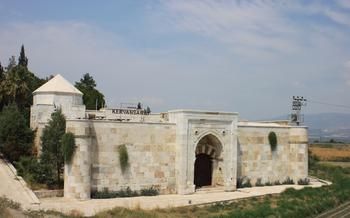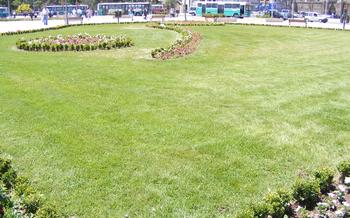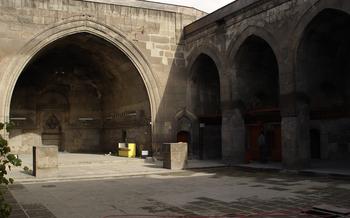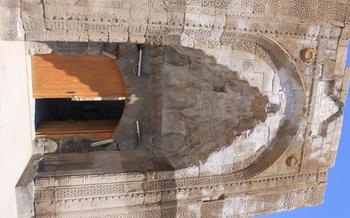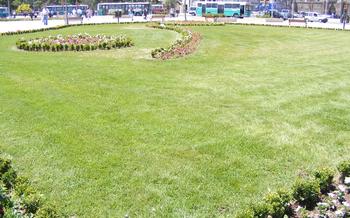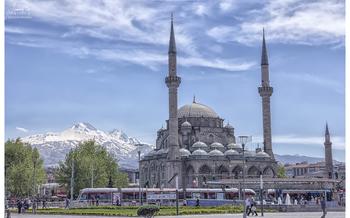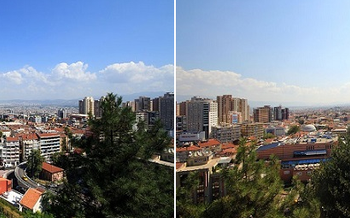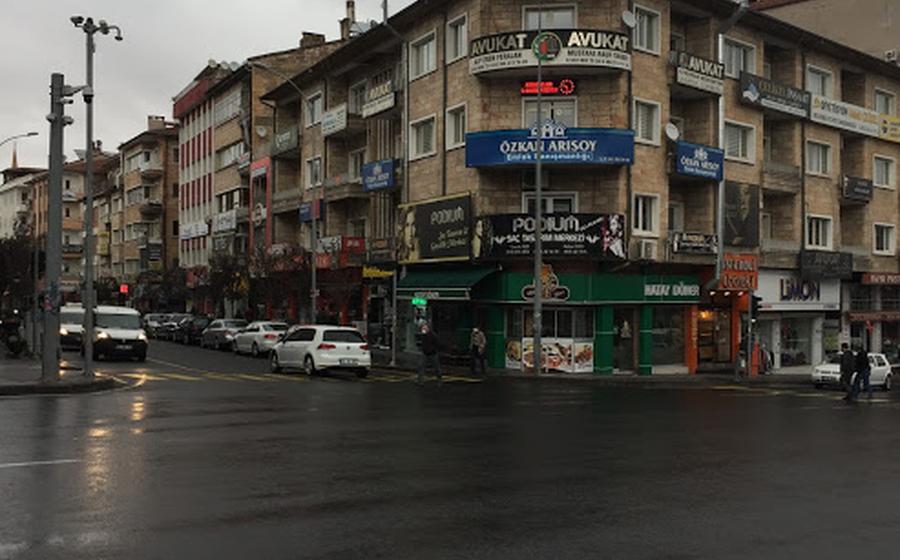
Agzikarahan Caravanserai
- A Journey to the Past: Unveiling the Agzikarahan Caravanserai
- Location and Transportation: Navigating Your Way to the Caravanserai
- Step Back in Time: Exploring the Caravanserai's History
- Architectural Masterpiece: Marveling at the Caravanserai's Design
- Exploring the Caravanserai's Interiors: Unveiling its Secrets
- A Thriving Hub of Activity: Imagining Life at the Caravanserai
- Artistic Expressions: Discovering the Caravanserai's Artwork
- Abode of Caravans: Experiencing the Caravanserai's Accommodations
- Culinary Delights: Savoring the Flavors of the Caravanserai
- Trade and Commerce: Exploring the Caravanserai's Marketplace
- Cultural Exchange: Fostering Connections at the Caravanserai
- Storytelling and Folklore: Unraveling the Legends of the Caravanserai
- Modern-Day Significance: Preserving the Caravanserai's Legacy
- Tips for Visitors: Enhancing Your Experience at the Caravanserai
- Insider Tip: Discovering Hidden Gems Nearby
A Journey to the Past: Unveiling the Agzikarahan Caravanserai
In the heart of Nevşehir, Turkey, lies the Agzikarahan Caravanserai, a majestic testament to the bygone era of the Silk Road. Constructed in the 13th century, this architectural marvel stands as a symbol of the region's rich history and cultural heritage. Once a bustling hub of activity, the caravanserai served as a resting point for weary travelers, merchants, and pilgrims traversing the ancient trade routes. Its strategic location along the Silk Road made it a vital link between East and West, facilitating the exchange of goods, ideas, and cultures.
The Agzikarahan Caravanserai boasts unique architectural features that reflect the ingenuity and artistry of its builders. Its imposing stone walls, adorned with intricate carvings and inscriptions, hint at the stories of countless individuals who passed through its gates. The caravanserai's layout is designed to provide both security and comfort, featuring a central courtyard surrounded by vaulted chambers and stables. These chambers, once home to weary travelers, offer a glimpse into the lives of those who sought refuge within the caravanserai's walls.
As we explore the caravanserai, we can't help but marvel at its relevance in understanding medieval travel and commerce. It serves as a living testament to the importance of these ancient trade routes, which connected diverse civilizations and facilitated the flow of knowledge, goods, and cultural influences across continents. Visiting the Agzikarahan Caravanserai is an immersive experience that transports us back in time, allowing us to witness the vibrant tapestry of a bygone era.
Location and Transportation: Navigating Your Way to the Caravanserai
Situated in the heart of Nevşehir, Turkey, the Agzikarahan Caravanserai beckons travelers with its rich history and architectural grandeur. To reach this hidden gem, visitors can embark on a scenic journey from nearby cities like Kayseri or Ürgüp. Public transportation offers a convenient option, with regular buses departing from these urban hubs. Alternatively, guided tours provide a comprehensive experience, allowing travelers to delve deeper into the caravanserai's captivating narratives. For those seeking a personalized adventure, private transportation offers the flexibility to explore the site at their own pace. Whether navigating the roads independently or joining an organized tour, the journey to the Agzikarahan Caravanserai promises an unforgettable voyage into the past.
Practical tips for self-guided exploration: - Plan your visit during the summer months for pleasant weather conditions. - Allocate sufficient time to explore the caravanserai's various sections and immerse yourself in its ambiance. - Wear comfortable shoes suitable for walking on uneven terrain. - Carry a camera to capture the caravanserai's architectural details and picturesque surroundings. - Engage with local guides or information centers to gain insights into the site's history and significance.
Step Back in Time: Exploring the Caravanserai's History
The Agzikarahan Caravanserai was constructed in the 13th century under the patronage of the Seljuk sultan Alaeddin Keykubat I. It served as a vital resting point for travelers and merchants traversing the Silk Road, a network of trade routes that connected the East and the West. The caravanserai played a crucial role in facilitating trade and cultural exchange between diverse regions.
Historical anecdotes and tales abound, adding to the allure of the Agzikarahan Caravanserai. Legend has it that the caravanserai was once visited by Marco Polo, the renowned Venetian explorer, during his travels along the Silk Road. Another story tells of a group of merchants who were attacked by bandits near the caravanserai but managed to seek refuge within its sturdy walls, escaping unharmed.
The caravanserai's strategic location made it a bustling hub of activity, attracting traders from far and wide. It provided a safe haven for travelers to rest, replenish their supplies, and exchange goods. The caravanserai also served as a center for cultural exchange, where people from different backgrounds and cultures interacted and shared ideas.
Architectural Masterpiece: Marveling at the Caravanserai's Design
The Agzikarahan Caravanserai stands as a testament to the architectural prowess of the Seljuk dynasty. Its design showcases distinctive features that blend Islamic and Anatolian architectural influences. The caravanserai's layout is centered around a large, open courtyard, which served as a gathering space for travelers and merchants. Surrounding the courtyard are various rooms and chambers, including guest rooms, stables, and a water cistern.
One of the most striking architectural elements of the caravanserai is its iwans, or vaulted chambers. These iwans provide access to the courtyard and feature intricate carvings and decorative tiles. The caravanserai's vaulted ceilings and arches add to its grandeur and create a sense of spaciousness.
The caravanserai's design also reflects its defensive function. Its thick walls and strategically placed towers provided protection from attacks. The caravanserai's gate, which is reinforced with iron, could be closed to prevent unwanted entry.
Overall, the Agzikarahan Caravanserai is a remarkable example of medieval architecture. Its design showcases the ingenuity and craftsmanship of the Seljuk builders and offers a glimpse into the architectural heritage of Turkey.
Exploring the Caravanserai's Interiors: Unveiling its Secrets
Delving into the heart of the Agzikarahan Caravanserai reveals a captivating array of spaces that served diverse functions. The main courtyard, a central gathering point, bustled with activity as travelers and merchants mingled, exchanged stories, and conducted business. Surrounding the courtyard, individual rooms and chambers provided shelter and privacy for weary travelers. These accommodations, though modest, offered a respite from the rigors of the journey and a sense of community among fellow wayfarers.
Venturing further, one encounters the caravanserai's water cistern, a vital resource in the arid Anatolian landscape. This ingenious underground reservoir ensured a steady supply of fresh water for both human consumption and the upkeep of the caravanserai's facilities.
Adjacent to the courtyard, stables accommodated the animals that carried the burdens of trade. These sturdy structures provided shelter and sustenance for the horses, camels, and donkeys that were indispensable companions on the Silk Road.
Intricate architectural details throughout the caravanserai invite closer examination. Carved stonework, geometric patterns, and decorative motifs adorn the walls and portals, showcasing the artistry and craftsmanship of Seljuk builders. These decorative elements not only enhance the aesthetic appeal of the caravanserai but also provide valuable insights into the cultural and artistic influences that shaped its design.
A Thriving Hub of Activity: Imagining Life at the Caravanserai
Imagine stepping back in time and witnessing the vibrant tapestry of life that unfolded within the walls of the Agzikarahan Caravanserai. As the sun cast its golden rays upon the ancient stone, a symphony of sounds and scents filled the air, creating a captivating atmosphere of trade, travel, and cultural exchange.
Merchants from distant lands haggled over prices, their voices blending in a cacophony of languages. The courtyard bustled with activity as travelers from all walks of life crossed paths, sharing stories, and experiences. The air was thick with the enticing aromas of exotic spices, freshly baked bread, and roasting meats, wafting from the caravanserai's kitchens.
In the evening, as the shadows stretched across the courtyard, the caravanserai transformed into a center of entertainment. Storytellers captivated audiences with tales of adventure, heroism, and romance, while musicians filled the air with enchanting melodies. The laughter and chatter of guests echoed through the corridors, creating a sense of camaraderie and community.
Imagine yourself seated among weary travelers, listening to tales of distant lands and marveling at the diversity of cultures represented within the caravanserai's walls. This was a place where strangers became friends, where ideas were exchanged, and where the spirit of exploration and adventure thrived.
Artistic Expressions: Discovering the Caravanserai's Artwork
The Agzikarahan Caravanserai is not only a masterpiece of architecture but also a repository of artistic expressions. Every corner of the caravanserai is adorned with intricate decorative elements that reflect the rich cultural heritage of the Seljuk period.
The caravanserai's entrance is embellished with mesmerizing Islamic calligraphy, showcasing verses from the Quran and intricate geometric patterns. Above the entrance, a beautifully carved frieze depicts a procession of animals, symbolizing the diversity of life and the journey of travelers.
Inside the caravanserai, the walls are adorned with vibrant frescoes and murals depicting scenes from everyday life, such as merchants trading goods, travelers resting, and animals grazing. The caravanserai's central courtyard features a stunning fountain with intricate carvings and a variety of geometric patterns.
The caravanserai's iwans, or vaulted chambers, are decorated with colorful tiles arranged in intricate patterns. These tiles often depict floral motifs, geometric designs, and even scenes from history or mythology. The caravanserai's ceilings are adorned with stunning muqarnas, or stalactite-like ornaments, creating a sense of grandeur and awe.
The artistic expressions found in the Agzikarahan Caravanserai are not merely decorative elements but also symbols and representations of the cultural and religious beliefs of the Seljuk people. Each artwork tells a story, conveys a message, or holds a deeper meaning, inviting visitors to unravel the mysteries and appreciate the beauty of this historic site.
Abode of Caravans: Experiencing the Caravanserai's Accommodations
The Agzikarahan Caravanserai provided weary travelers with a safe haven, a place to rest their heads and recharge for the journey ahead. The caravanserai's accommodations consisted of individual rooms and chambers, each designed to cater to the needs of its diverse guests. These rooms were typically small and simple, yet they offered a sense of comfort and privacy.
The rooms featured basic amenities such as sleeping mats, cushions, and blankets, ensuring a comfortable resting place for travelers. Some rooms even had fireplaces, providing warmth during the cold winter months. In addition to individual rooms, the caravanserai also had larger chambers that could accommodate groups of travelers or families. These chambers were often used by merchants traveling with their goods or pilgrims on religious journeys.
Beyond the individual rooms, the caravanserai also provided communal spaces where guests could socialize and share stories of their travels. These spaces included a central courtyard, where travelers could gather to exchange news, trade goods, or simply relax and enjoy each other's company. The caravanserai's design fostered a sense of community among its guests, creating a welcoming environment for all who passed through its gates.
Culinary Delights: Savoring the Flavors of the Caravanserai
Food and hospitality were integral aspects of caravanserai culture, and the Agzikarahan Caravanserai was no exception. Travelers and merchants could expect to savor a variety of cuisines and dishes during their stay. Local ingredients and traditional recipes took center stage, offering a taste of the region's culinary heritage.
The caravanserai's kitchens bustled with activity as skilled chefs prepared mouthwatering meals for weary travelers. The air was filled with enticing aromas, tantalizing the senses and inviting guests to indulge in a culinary feast. From hearty stews and succulent roasts to fresh salads and flavorful flatbreads, the caravanserai's menu catered to diverse palates.
The communal dining experience at the caravanserai was a highlight for many visitors. Travelers from different cultures and backgrounds gathered around shared tables, breaking bread and engaging in lively conversations. These meals were not merely about sustenance; they were opportunities for cultural exchange and camaraderie.
The caravanserai's chefs took pride in showcasing local specialties, ensuring that guests experienced the true flavors of the region. Traditional recipes passed down through generations were carefully followed, resulting in dishes that were both authentic and delicious.
Whether it was a simple breakfast to start the day or a lavish feast to celebrate a successful journey, the Agzikarahan Caravanserai offered a culinary experience that was as memorable as the journey itself.
Trade and Commerce: Exploring the Caravanserai's Marketplace
The Agzikarahan Caravanserai was not merely a resting point for weary travelers; it was also a bustling hub of trade and commerce. Merchants from far and wide converged at this crossroads to exchange their goods and wares. The caravanserai's strategic location along the Silk Road made it an ideal marketplace for a diverse array of products.
Traders from the East brought exotic spices, silks, and precious stones, while those from the West offered textiles, glassware, and metalwork. The caravanserai's marketplace was a cacophony of sounds and smells, with merchants haggling over prices and customers browsing the wares on display.
The exchange of goods at the caravanserai was not limited to material objects. Ideas, technologies, and cultural influences were also disseminated through trade. Merchants shared their knowledge of different lands, customs, and beliefs, contributing to the cross-pollination of cultures.
The caravanserai's marketplace played a crucial role in the economic development of the region. It facilitated the flow of goods and services, stimulated local production, and generated revenue for the surrounding communities. The caravanserai's legacy as a center of trade and commerce continues to this day, as it attracts visitors from around the world who are eager to experience a glimpse of this vibrant past.
Cultural Exchange: Fostering Connections at the Caravanserai
The Agzikarahan Caravanserai served as a vibrant hub of cultural exchange, where people from diverse backgrounds converged and shared their traditions, beliefs, and customs. It acted as a melting pot of cultures, fostering a sense of unity and understanding among travelers and merchants from different parts of the world.
As people from various regions gathered at the caravanserai, they engaged in conversations, shared stories, and exchanged ideas. This cross-cultural interaction played a vital role in bridging cultural divides and promoting mutual respect and understanding. The caravanserai facilitated the spread of knowledge, innovations, and artistic influences across vast distances, contributing to the enrichment of local cultures.
The caravanserai's role in cultural exchange extended beyond mere interactions between travelers. It also served as a platform for cultural performances, storytelling sessions, and artistic expressions. These events provided an opportunity for people to showcase their talents, share their cultural heritage, and appreciate the diversity of traditions represented within the caravanserai's walls.
Through this vibrant exchange of ideas and experiences, the Agzikarahan Caravanserai played a pivotal role in shaping the cultural landscape of the region. It fostered a sense of unity and belonging among people from different backgrounds, contributing to the development of a rich and diverse cultural tapestry that continues to inspire and fascinate visitors to this day.
Storytelling and Folklore: Unraveling the Legends of the Caravanserai
Over the centuries, the Agzikarahan Caravanserai has accumulated a rich tapestry of stories and legends that have been passed down from generation to generation. These tales, often embellished with mythical elements, offer a glimpse into the caravanserai's vibrant past and the lives of those who traveled its ancient routes.
One popular legend tells the story of a young couple who were separated during a Mongol invasion. The young man was taken captive, while the woman escaped to the caravanserai, where she waited patiently for his return. Years later, after enduring countless hardships, the man managed to escape and found his way back to the caravanserai, where he was reunited with his beloved.
Another tale speaks of a mysterious traveler who arrived at the caravanserai on a stormy night. The traveler, who possessed a magical lute, played enchanting melodies that captivated everyone who heard them. As the music filled the air, the caravanserai's courtyard transformed into a realm of wonder, where people from all walks of life danced and celebrated amidst a surreal atmosphere.
These legends and stories, deeply rooted in local folklore, add an enchanting layer to the Agzikarahan Caravanserai's already rich history. They invite visitors to step back in time and imagine the captivating tales that unfolded within its walls, preserving the caravanserai's legacy as a place of wonder, magic, and timeless allure.
Modern-Day Significance: Preserving the Caravanserai's Legacy
In recent years, the Agzikarahan Caravanserai has undergone extensive restoration efforts aimed at preserving its architectural integrity and historical significance. These efforts have been instrumental in transforming the caravanserai into a valuable heritage site, attracting visitors from around the world. The restoration process involved careful attention to detail, ensuring that the caravanserai's original features and charm were maintained. Today, the caravanserai stands as a testament to the rich history of the Silk Road and the enduring legacy of Anatolian architecture.
Preserving cultural landmarks like the Agzikarahan Caravanserai is of paramount importance for several reasons. First and foremost, these landmarks represent a tangible connection to our past, providing valuable insights into the lives and experiences of our ancestors. By preserving them, we ensure that future generations can appreciate and learn from the cultural heritage that has shaped our societies. Additionally, these landmarks serve as a source of inspiration and creativity, fostering a sense of cultural identity and pride.
Furthermore, the preservation of cultural landmarks contributes to the development of sustainable tourism. By promoting heritage sites as tourist destinations, we can attract visitors who are interested in learning about and experiencing different cultures. This, in turn, generates revenue that can be used to support local communities and promote economic growth. The Agzikarahan Caravanserai, with its unique blend of historical significance and architectural beauty, is an ideal example of a cultural landmark that has been successfully transformed into a sustainable tourism destination.
Tips for Visitors: Enhancing Your Experience at the Caravanserai
Plan your visit during the spring or fall months to enjoy pleasant weather conditions. The winter months can be harsh with limited access to the site, while the summer months tend to be crowded with tourists.
Set aside at least two to three hours to thoroughly explore the caravanserai and immerse yourself in its history. Allocate sufficient time to wander through the courtyards, chambers, and stables, and to admire the intricate architectural details.
Remember to dress respectfully, covering your shoulders and knees. The caravanserai is a sacred place for many, and modest attire is recommended.
Capture the beauty of the caravanserai through photography, but be mindful of other visitors and avoid disturbing their experience.
Combine your visit to the caravanserai with a trip to the nearby Göreme National Park, a UNESCO World Heritage Site renowned for its stunning fairy chimneys and rock-cut churches.
For a unique experience, consider staying overnight at a local guesthouse or hotel in the nearby town of Ürgüp. This will allow you to soak in the atmosphere of the region and fully immerse yourself in the history and culture of the caravanserai.
Insider Tip: Discovering Hidden Gems Nearby
Beyond the enchanting allure of the Agzikarahan Caravanserai, the surrounding region offers a treasure trove of hidden gems waiting to be explored. Just a short distance away, nestled amidst the serene landscapes, you'll find lesser-known historical sites and natural wonders that will captivate your senses. Discover ancient ruins that whisper tales of forgotten civilizations, marvel at the breathtaking vistas from secluded mountain peaks, and immerse yourself in the tranquility of hidden waterfalls and lush forests.
For a culinary adventure, venture off the beaten path and seek out the local culinary delights. Authentic restaurants, tucked away in charming villages, offer mouthwatering dishes that showcase the region's rich culinary heritage. Indulge in traditional recipes passed down through generations, savoring the flavors that have delighted locals for centuries.
To truly immerse yourself in the region's culture, embrace the unique experiences that await. Engage with the friendly locals, learn about their customs and traditions, and participate in local festivals and events. Explore the surrounding countryside, where you'll encounter traditional villages, bustling markets, and breathtaking landscapes that will leave you spellbound.
Remember, the key to uncovering these hidden gems lies in your willingness to venture beyond the ordinary and embrace the unexpected. Let your curiosity guide you as you explore the region, discovering the secrets that lie just beneath the surface, waiting to be revealed to those who seek them.
